In the rapidly evolving world of cryptocurrency and blockchain technology, the rise of AI and machine learning has become increasingly prominent. As these cutting-edge technologies continue to advance, they are poised to revolutionize the way we interact with and utilize decentralized applications and systems. Enter Spectral, a groundbreaking project that aims to bridge the gap between the centralized nature of AI models and the decentralized principles of Web3 and blockchain.
1. What is Spectral?
Spectral is a innovative infrastructure that combines the power of AI, machine learning, and blockchain to create a transparent, decentralized ecosystem for AI agents and applications. Recognizing the inherent conflict between the centralized data models used in AI training and the decentralized, censorship-resistant nature of blockchain, Spectral set out to find a solution.
2. The Spectral Ecosystem
Spectral’s core offering consists of two key components: Spectral Syntax and Spectral Nova.
2.1. Spectral Syntax
Spectral Syntax is co-pilot software that allows users to create their own AI agents. Through a series of Large Language Models (LLMs) fine-tuned with the Solidity programming language, users can easily create different AI agents simply by entering their requirements into the chat interface. As a result, Spectral Syntax can build an efficient AI agent economy by making the process of creating and interacting with AI agents more accessible.
Spectral Syntax includes several coordinated modules for operation, including:
- Base Models – This is the core system that handles communication and data processing.
- Agent Identities – This keeps track of different “agents” (software programs) and evaluates how well they perform.
- Agent Knowledge Bases – These are the data sources that the agents use for their knowledge.
- Plugins – These allow the system to access additional necessary data from external sources like oracle feeds or the internet.
- ML Inferences – The machine learning system that does the computations.
- Wallet Management – A system for managing cryptocurrency wallets using Account Abstraction (AA) wallets that follow the ERC-4337 standard.
The operational model of Spectral Syntax:
- First, the user inputs their requirements at the user interface.
- The Orchestrator analyzes the request and builds the context using the LLM system.
- Based on the processed request, the Orchestrator finds the appropriate agents and delegates the task to them.
- The Agent Handler then queries additional data needed to build an enhanced request with full information, preparing for the response generation.
- The Agent Handler calls the Language Model (LLM) and sends the enhanced request for computation. It then sends the result back to the Orchestrator to determine if additional plugins are needed to fetch supplementary data, repeating the process until the Orchestrator is satisfied with the result.
- Finally, the result is returned to the user through the user interface, completing the workflow.
2.2. Spectral Nova
Spectral Nova is a machine intelligence network that serves as a decentralized data source. Spectral Nova encourages researchers and engineers in the field of Machine Learning to build models that provide data for Web3 applications.
The key components of Spectral Nova are:
- Creators: Web3 companies that run data science/ML challenges, set performance targets, and offer rewards. They earn a cut of the revenue from the use of the resulting inference models.
- Solvers: Individuals/teams that solve the challenges. They can win bounties and receive most of the ongoing revenue when their models are used by Consumers.
- Validators: Ensure the integrity and quality of the Solver models. They use randomness beacons to create unique test sets, verify the model outputs, and confirm they meet the Creator’s benchmarks.
- Consumers: Discover and pay to access the validated inference feeds that fit their needs, integrating them into their own applications.
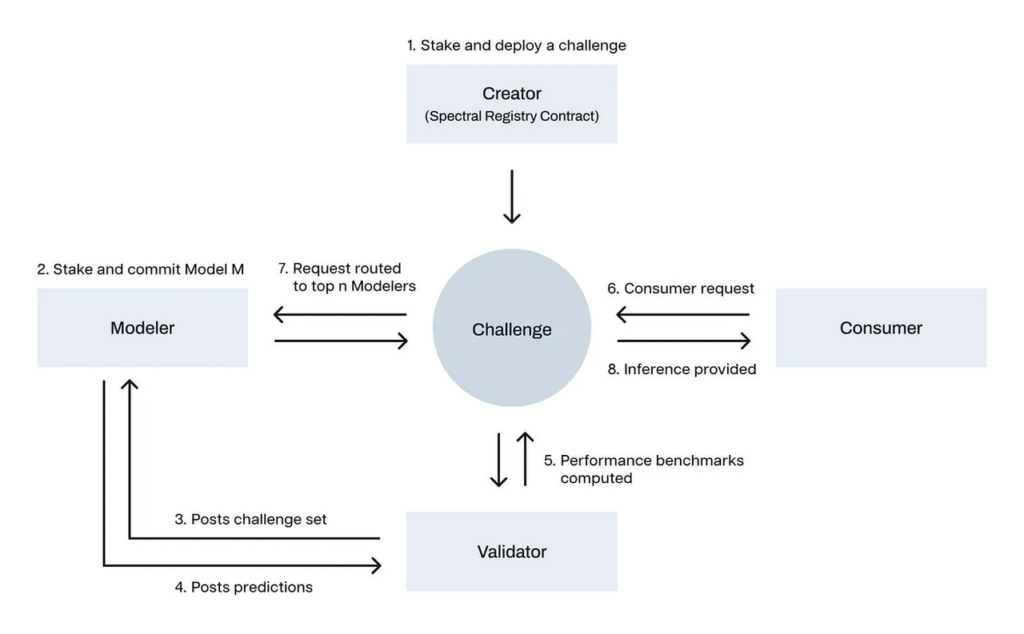
- Creators: find relevant data science challenges and post them to the Spectral Machine Intelligence Network. Once a challenge is live, anyone in the global Spectral community can try to solve it.
- Solvers (modeler): build models to solve the challenges posted by the Creators. When a Solver is ready, they commit their model as their official submission for that challenge.
- Validators: After a Solver commits their model, they receive a dataset from one of the independent Validators. The Validators use this to assess the quality and performance of the Solver’s model. The Solvers compute test inferences using their model and submit them along with cryptographic proofs to the Validators.
- Validators check the inferences against the challenge’s performance targets and verify the proofs. Once validated, the Solver’s model is ranked on the challenge’s leaderboard. Only the top-performing models are eligible for use by Consumers.
- Consumers: who want to use the high-quality inference models from the Spectral challenges. They can request an aggregate feed of top models or a custom feed from a specific Solver’s model. The relevant Solver(s) then compute the inferences and provide them to the Consumer, all handled seamlessly through smart contracts.
3. Roadmap
Spectral Nova was launched and started its first Challenge in November 2023, with over 400 Solvers participating and about 20% of the models receiving awards from the challenge.

Spectral’s 2024 Roadmap Spectral’s development roadmap for 2024 and 2025 includes the following phases:
- Q1 2024 – Inception: Launch the Machine Intelligence Network and release the SPEC governance token on the Alpha Mainnet.
- Q2 2024 – Scaling: Launch the 2nd Challenge focused on a Solidity LLM system. Establish a decentralized Validator system and onboard Creators.
- Q3 2024 – Diversification: Diversify the inference data sources to include offerings like an NFT Recommendation Engine, Uniswap X Filters, and Multimodal Solidity LLMs.
- Q4 2024 – InferChain: Deploy on-chain AI/ML inferences on the testnet.
- 2025: InferChain Mainnet launch.
4. The Team
The project does not publicly disclose the full development team details, but here are some key members based on the project’s LinkedIn profile:
- Sishir Varghese – CEO & Co-Founder: Joined Spectral in June 2020, with significant experience in technology and finance. Completed the Kernel Fellowship at Gitcoin, was a Strategic Partner at Loopring for over 2 years, and previously worked as an Architect at The Jerde Partnership.
- Mihir Kulkarni – Head of Product: Experienced in blockchain. Prior to Spectral, he was an SVP at Truist building decentralized identity services, improved technical support processes at Coinbase, and developed Ethereum contract platforms at EY and designed blockchain tokens at Sacred Capital.
5. Investors
Spectral has raised a total of $29.82 million across 3 funding rounds:
- $6.75 million in the first round in November 2021, led by Polychain Capital.
- $23 million in the second round in August 2022, led by Social Capital and General Capital. Other notable crypto investors included Circle, Jump Capital, and Franklin Templeton.
- Most recently, a $70,000 IEO on the Gate Startup platform.
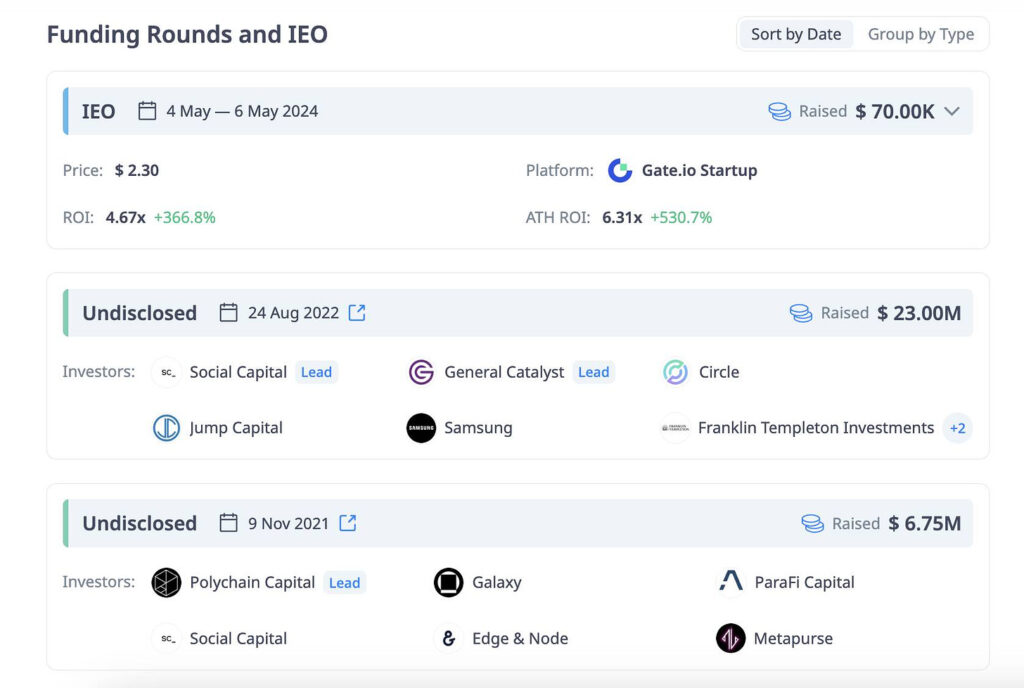
6. Tokenomics
Token metrics
- Token name: Spectral
- Ticker: SPEC
- Total max supply: 100,000,000 (100M)
- Network: Ethereum
- Standard: ERC20
- Contract address: 0xAdF7C35560035944e805D98fF17d58CDe2449389
- Status: TGE and listing
Allocation
- Investors: 38%, locked for 12 months then linearly unlocked over 18 months
- Team & Contributors: 22%, locked for 12 months then linearly unlocked over 30 months
- Airdrop + Market Makers: 10.3%, fully unlocked at TGE
- Foundation Treasury: 29.7%, lockup schedule not publicly disclosed
Use Cases
- Payment method for activities within the Spectral network
- Staking on Spectral Syntax or Nova to receive benefits like becoming a validator, discounted service fees, and unlocking other perks
- Participation in protocol governance
7. Closing Thoughts
Spectral is attracting notable attention from the crypto community due to its efforts to bridge the gap between Machine Learning, AI, and Blockchain. The project’s roadmap is progressing well, as it is currently developing a monetization model as part of the upcoming Syntax V2 update scheduled for Q3 2024.
Spectral’s approach of building a comprehensive “Inference Economy” for Web3 is particularly interesting. With this innovative model, the project aims to continuously improve and further enhance its token economy over time.
The information provided in this article is for reference only and should not be taken as investment advice. All investment decisions should be based on thorough research and personal evaluation.


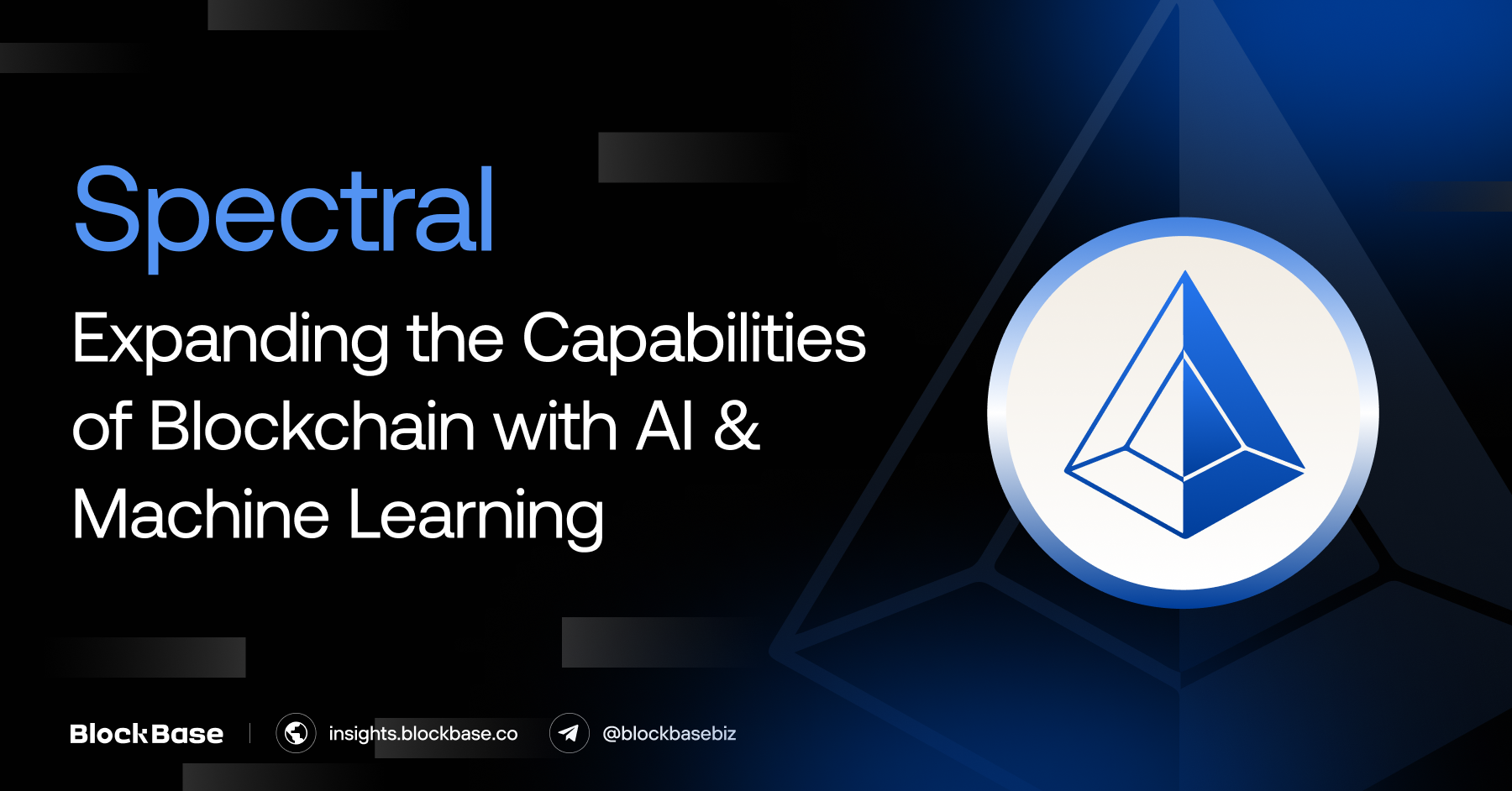
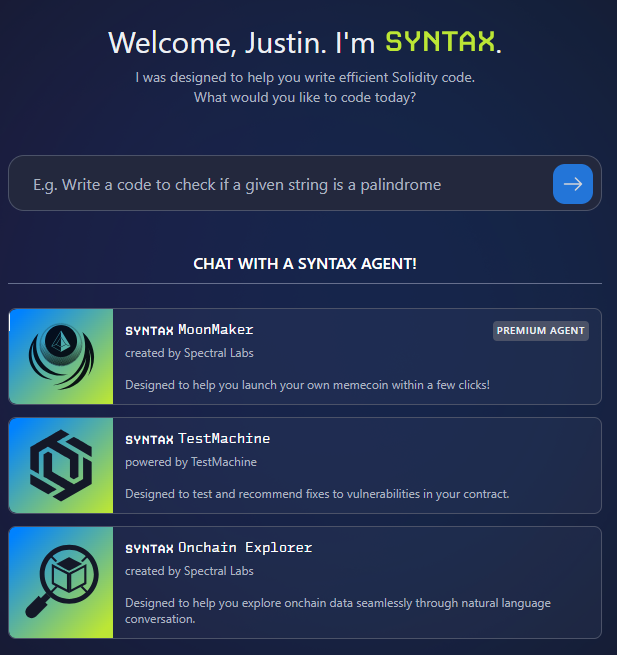
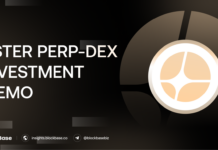
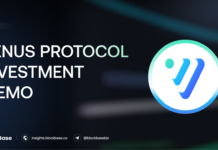

[…] Spectral – Expanding the Capabilities of Blockchain With AI and Machine learning […]
[…] Spectral – Expanding the Capabilities of Blockchain With AI and Machine learning […]
Comments are closed.